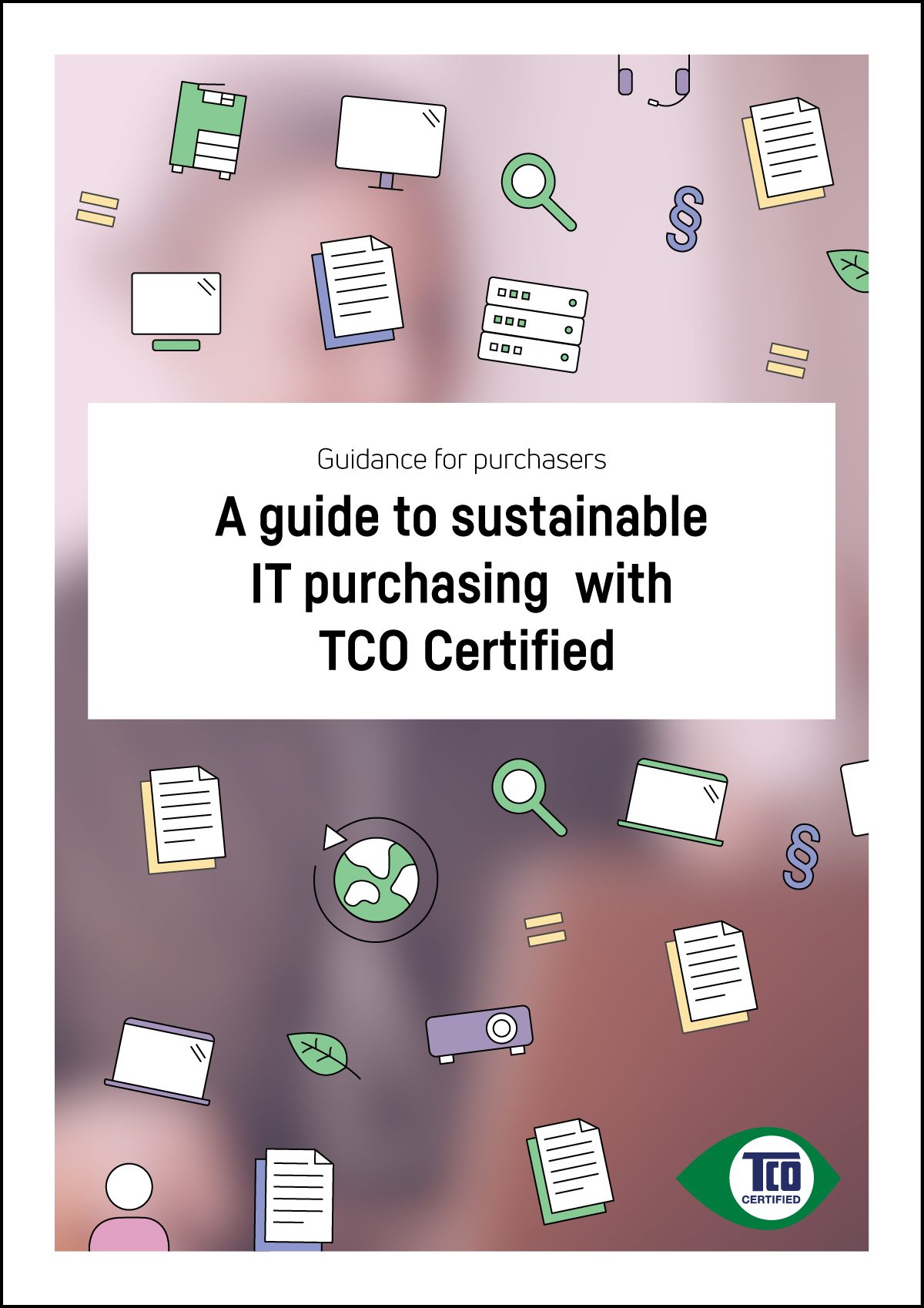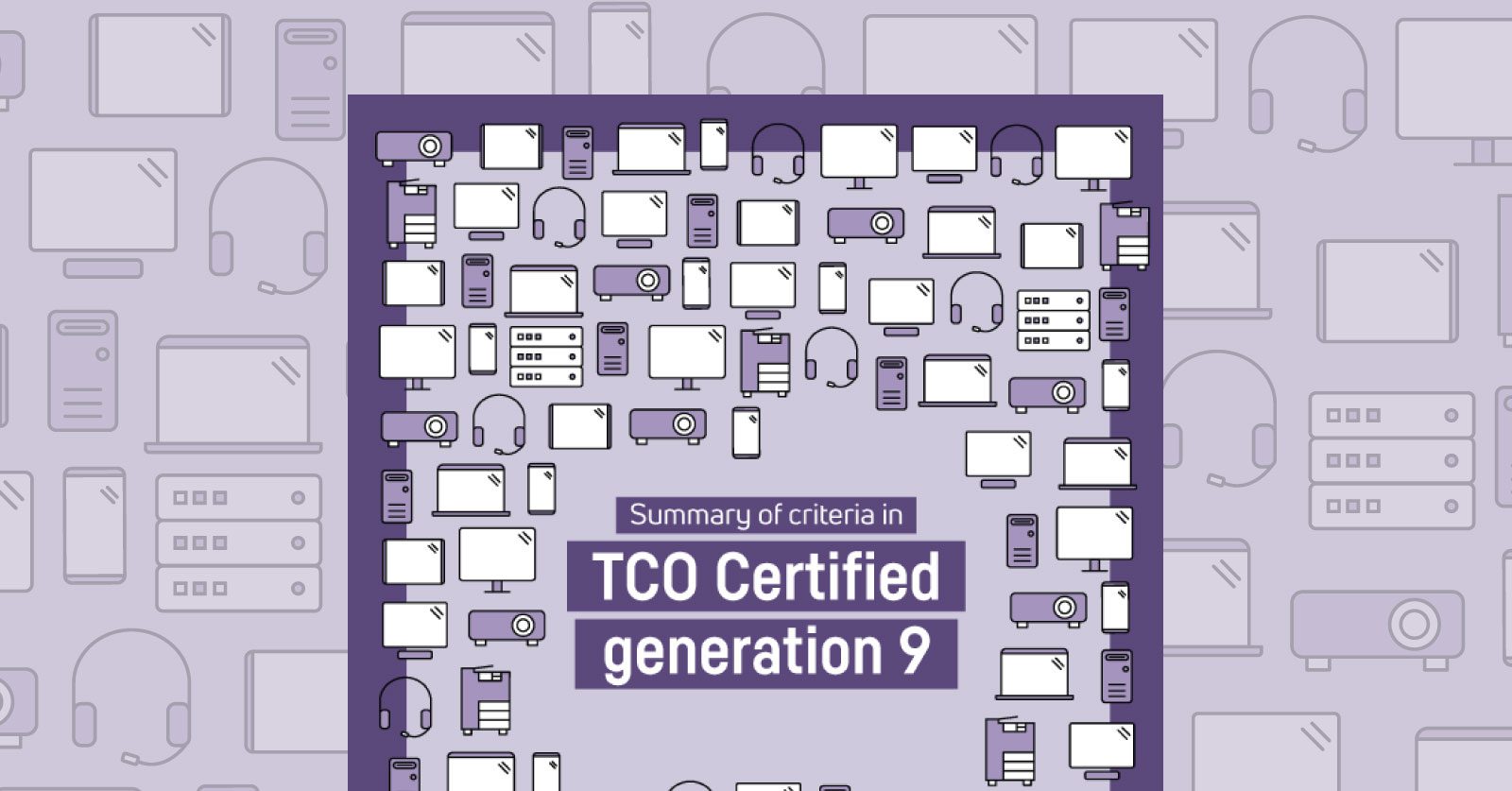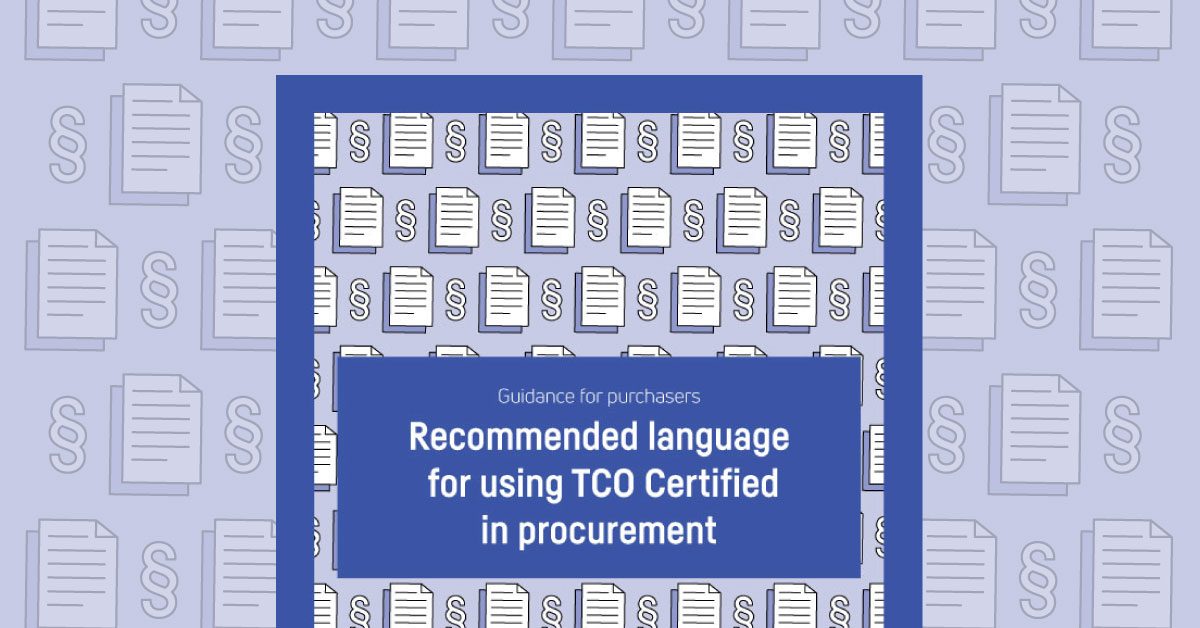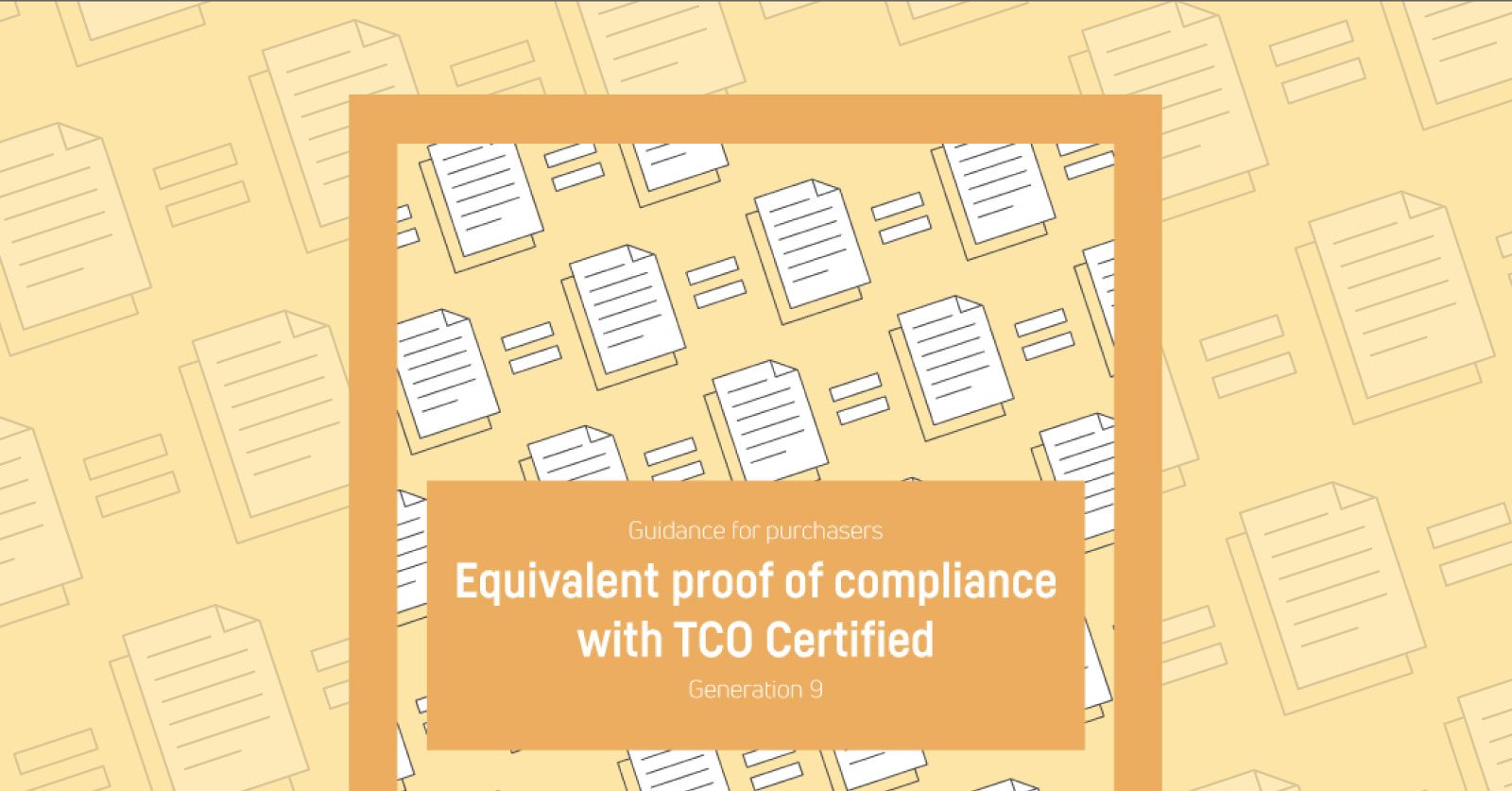– Step-by-step guide for purchasers
How to use TCO Certified in IT procurement
Including TCO Certified in procurement policies and tenders is an easy, independently verified way to drive environmental and social responsibility in the life cycle and value chain of electronics. Our step-by-step guide helps you get started and offers practical tips along the way.
THE QUICK WAY
Plug TCO Certified into procurement language
Using TCO Certified in procurement is as easy as citing it in your procurement language. You don’t need extensive knowledge of sustainability or a network of experts with access to factories worldwide. We set relevant criteria and verify compliance for you, saving you valuable time and resources.
Here’s an example of how to cite TCO Certified:
[Product category/categories] delivered under this contract must be certified in accordance with TCO Certified upon product delivery. As proof of criteria fulfillment, the product shall be listed in TCO Development’s Product Finder, available at tcocertified.com/product-finder.
More examples of how to include TCO Certified in procurement policies and tenders are available here.
THE COMPREHENSIVE WAY
Getting more out of your sustainable IT strategy
Simply plugging TCO Certified into your procurement language will send a signal to the IT industry that sustainability is a top priority for your organization. However, taking a strategic approach towards your sustainability goals and commitments will provide you with more chances to influence your suppliers and effectively measure your impact.
STEP 1
Prepare your organization
Check your product portfolio in Product Finder
You can easily check the certification status of your current product portfolio by using our Product Finder tool, which lists all certified product models. You’ll find thousands of certified products from well-known brands, and you might even find some of the products you’re already using are among them. However, it’s important to note that even if you’re currently using certified products, it’s still important to specify TCO Certified in your next tender to show that sustainability is a priority for you. This will also send a clear signal to the IT industry about the importance of sustainability.
Set your goals
Your work with sustainable procurement will be easier if your organization already has set goals for environmental and social sustainability. These goals should ideally include social and environmental sustainability aspects such as climate, hazardous material content, worker protections in the supply chain, and circularity, where a longer product use time is an important part. TCO Certified covers all these aspects and can help you meet your goals in an efficient way.
Identify key data points that help you measure the effects of procuring and using IT products in a more sustainable way, for internal or external reporting, and to meet legal requirements.
Include TCO Certified in policy documents
Consider including a clause specifically titled “sustainability certifications and ecolabels” in your procurement policy, and make it clear that trustworthy certifications should be used to select the most sustainable products on the market, when available.
Engage your colleagues
Aligning your organization’s priorities and internal commitments is an important first step in any sustainable procurement program. Cooperation between functions is vital and will help you make faster progress. Invite decision-makers and specialists from at least IT, procurement, sustainability, finance, facilities and communication for regular planning dialogs on sustainability, and explain why and how you should use TCO Certified.
Get internal buy-in
Sometimes colleagues and management need to be convinced. Build internal buy-in by reading up on the sustainability impacts of IT products throughout the supply chain, including climate, depletion of natural resources, e-waste, hazardous substances, and social impacts. Identify clear incentives — what are the benefits of purchasing more sustainable IT products? It could be reduced risks, lower climate impact, better operative results or lower life cycle costs for IT management.
STEP 2
Talk to you suppliers
Involve suppliers early
Discussing your sustainability priorities and your intention to specify TCO Certified with your supplier early in the procurement planning phase will help them align with your requirements and deliver the certified models you want. Use pre-competitive dialogs, such as Requests for Information (RFIs) to gather information from suppliers and get the dialog started. Other topics to include are your plans for first and second use, opportunities to purchase refurbished or remanufactured devices, and your need for credible data for reporting.
Allow time for brands to get their products certified
IT brands often apply for certification as a response to purchaser demand. Therefore, including TCO Certified in procurement helps drive industry progress and ensures the availability of certified products. If you want to purchase product models that are not yet certified, it is even more important to inform your suppliers of your intention to specify TCO Certified in good time (for example, six months in advance of your Request For Proposal). This way, they have time to apply for certification and go through all the product tests, assessments and audits that are needed in order to get products certified.
STEP 3
Include TCO Certified in your specifications
Make sustainability a priority
Now you’re ready to get TCO Certified into your procurement specifications. The best way to do this is to specify TCO Certified for all relevant product categories. You can also use TCO Certified as a qualification and evaluation criterion to set a minimum level of product sustainability performance. Give sustainability factors the highest possible percentage weighting — at least 30% is recommended.
Specify TCO Certified in the tender
Make supplying certified models a requirement of complying with your terms. Specify in the tender that products included in your IT hardware contract must be “certified in accordance with TCO Certified” during the whole contract period.
Write for example:
[Product category/categories] delivered under this contract must be certified in accordance with TCO Certified upon product delivery. As proof of criteria fulfillment, the product shall be listed in TCO Development’s Product Finder, available at tcocertified.com/product-finder and a certificate of proof shall be available upon request.
Also, specify that supplied products must maintain “an active TCO Certified certificate for the duration of the whole contract period”. This is important, particularly if the manufacturer updates the product model during that time. The TCO Certified certificate is valid for two years, with the option to extend in one-year periods.
If you’re in a region where you need to show equivalent proof of compliance, please refer to our guide Equivalent proof of compliance with TCO Certified.
Consider giving vendors a qualification period
If products are not yet certified you can consider giving the vendor a qualification period (e.g. six months) to get those products certified according to TCO Certified. In this way, you can accept bids from suppliers, even if all specified product models are not yet certified.
Reach out to bidders that did not win
Once the bidding process is over, reach out to suppliers that did not win the contract. If they scored low on sustainability or didn’t deliver certified products on time, this is a good opportunity to start a dialog about how meeting your sustainability ambitions can help them be more competitive in future bids.
STEP 4
Stay true to the contract
Keep the dialog going
Communicate regularly with your vendors to ensure continued availability of certified products, as models are refreshed or a new generation of TCO Certified is released. An ongoing dialog also gives you an opportunity to discuss other topics included in the contract, such as e-catalog listings, reporting of refurbished products, data removal certificates, and responsible e-waste handling.
Hold suppliers accountable
Follow up regularly with your suppliers to make sure they deliver certified products throughout the duration of the contract. This is especially important in case product models are refreshed. An active certificate means that the TCO Certified system continues to monitor product and factory compliance, saving you time and resources. Check the certification status of your product portfolio in our Product Finder.
Keep an eye on the e-catalog
If your supplier lists products in an e-catalog, make sure that certified products are marked as preferable and are searchable. This will make it easier for people in your organization to make sustainable choices.
Stay up-to-date with Product Finder
Use Product Finder to stay updated on certified models and certificate validity dates. The Product Finder watcher function allows you to set up a customized, real-time tracking feature that delivers regular updates on product certification status.
STEP 5
Track your progress
Connect back to your goals
Once you’re using TCO Certified in procurement and you’re receiving certified products, tracking your progress will be key to ensuring your procurement program has the impact you want. Make sure you use reliable data in reporting. Industry self-declarations and other unverified product claims lead to a high risk of greenwashing.
Create customized reports in Report Generator
With Report Generator, you can create customized product sustainability reports for the certified IT products your organization uses. The reports include independently verified data and claims to support your sustainability strategy, reporting and communications.
Data and claims cover:
- Climate: product carbon footprint and scope 2 & 3 emissions.
- Substances: hazardous substances and safer substitutions.
- Circularity: material footprint, extended product life, and e-waste.
- Supply chain: social and environmental responsibility in the supply chain.
Share your successes
Communicating progress to colleagues helps create engagement in your sustainability and sustainable procurement goals. Reporting areas can for example include climate impact, waste, average service life for products, and the number of product categories where supply chain responsibility is addressed.

Download printable guide with a checklist!
Following our step-by-step guide for how to use TCO Certified in procurement will help you leverage your purchasing power, meet your sustainability goals, and measure your progress.
Download a printer-friendly pdf version here. It contains the full guide, plus a checklist that can help you structure your work with sustainable procurement. Print it out, put it on the wall, and tick off the steps you’ve already completed.
- Includes more than 35 practical tips
- Full version of the step-by-step guide
- Checklist helps you stay organized
More guides for sustainable IT procurement
A detailed summary of all criteria, for all 11 product categories in TCO Certified.
Text samples for including TCO Certified in tenders, policies, and other procurement documentation.
List of proof that is needed for a non-certified product model to be considered equal to a certified one.




